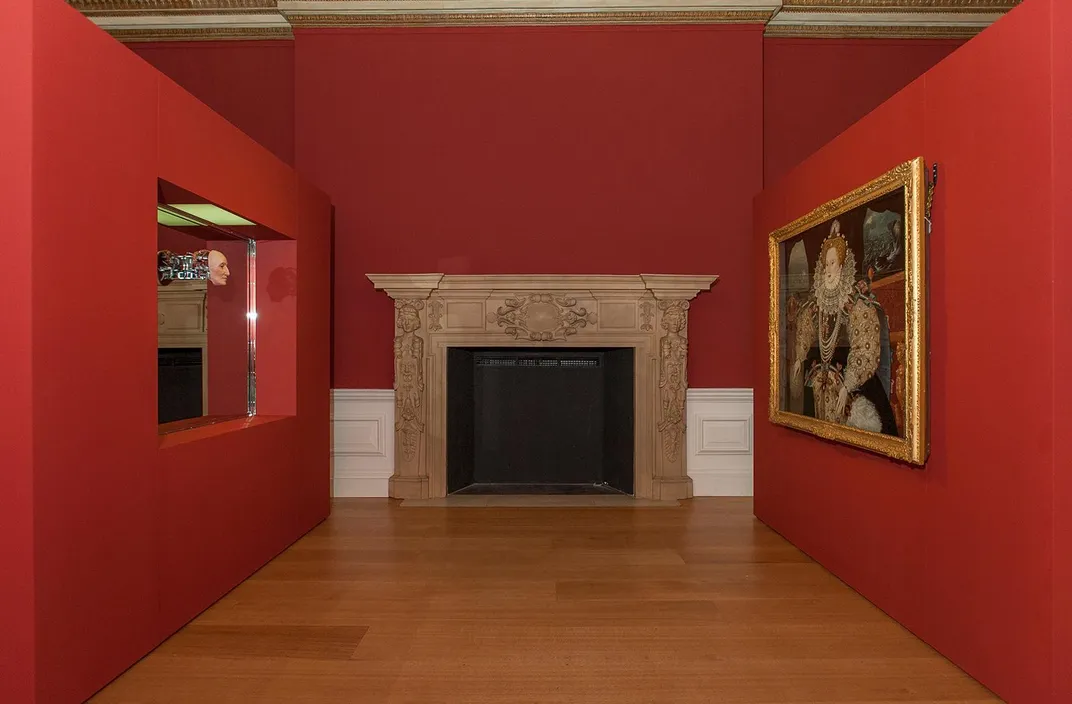What Did Elizabeth I Actually Look Like? This Artist Has a Suggestion
Mat Collishaw’s ‘Mask of Youth’ presents realistic depiction of the Tudor queen, explores her savvy command of public persona
/https://tf-cmsv2-smithsonianmag-media.s3.amazonaws.com/filer/76/71/7671b556-d962-4516-a5d5-19db882e5d29/3181.jpg)
During her 45-year reign, England’s Elizabeth I carefully cultivated her public image. She did such a good job of managing it that nearly 500 years after her rise to power, her imperial majesty continues to be depicted with a lithe figure, whose shape is emphasized by delicate lace collars, a smooth ivory complexion, and vibrant red hair dotted with precious jewels.
As Jonathan Jones reports for the Guardian, a new mixed-media installation by British artist Mat Collishaw complicates the visual we have of the last Tudor monarch, showing her as a master of artifice who crafted and controlled the mask she presented to the world, particularly as she grew older and fell victim to increasingly poor health.
“The proliferation of portraits seemed to set up a smoke screen more than it revealed her true character, which remained concealed behind her inscrutable appearance,” Collishaw explains in an interview published on the Royal Museums Greenwich blog. “Years of insecurity, due to the potentially volatile political climate, led her to create a public mask which became fused with her private self, the two becoming inseparable.”
Collishaw’s creation, fittingly entitled “The Mask of Youth,” renders this theory tangible by juxtaposing an animatronic, life-like and realistically unflattering depiction of Elizabeth with the triumphant "Armada Portrait," which was produced around 1588 to commemorate Philip II of Spain’s failed invasion of the British Isles.
On one wall of an exhibition hall in the Queen’s House, Greenwich, Elizabeth appears serene, omnipotent and incredibly youthful for a woman of roughly 55. The pearls in her hair speak to the “chastity” of England’s “Virgin Queen,” while the lace ruff surrounding her face radiates “warmth, beauty and goodness,” per the RMG blog.
/https://tf-cmsv2-smithsonianmag-media.s3.amazonaws.com/filer/18/69/18694ea0-ae36-4957-a409-ce364c36adf7/elizabeth_i_armada_portrait.jpg)
On the wall directly across from this image, a different version of Elizabeth appears. As Lucy Davies notes for the Telegraph, this queen bears all the hallmarks of her age: sunken eyes, wrinkles, smallpox-scarred skin and even wispy chin hairs. She’s missing her famed red hair—not to mention a corporeal body. Instead, she is little more than a rubber mask installed in a glass box. Behind her sits a jumble of whirring machinery that dictates her movements, from unnervingly blinking eyes to quavering mouth; the ultimate effect, Jamie Rigg writes for Engadget, is that of a silent queen surveying her court, physically unmasked to reveal the face behind the facade but concealing her inner thoughts just as she did in both portraits and life.
It’s not surprising that Elizabeth was adept in the art of crafting and maintaining an image: As the second daughter of a king yearning for sons and the product of an annulled union that ended with her mother’s execution on trumped up charges of adultery, she spent her life hiding behind a mask of her own creation. There were few other options if she hoped to survive the rise and fall of the kings and queens who ruled before she took power—an arduous task that she navigated by concealing her true intentions and beguiling those around her until Mary I died childless in 1558, leaving her sister Elizabeth heir to the throne.
Determined to maintain her independence, the 25-year-old queen decided to remain unmarried. For History Extra, Anna Whitelock writes that the queen’s “body was held to be one and the same as England.” When Elizabeth was young, vivacious and seemingly bound to produce a bevy of male heirs, this equation of private and public worked in her favor. When she was beyond childbearing years, with her balding grey hair, wrinkles and rotting teeth partially masked by heavy cosmetics and wigs, the emphasis on appearance proved more problematic.

Portraits became a key method of maintaining the myth of the queen’s youthful beauty, the Telegraph’s Davies notes. Toward the end of her reign, Elizabeth issued a “face template” that portrait artists were commanded to adhere to, and as Brenda Ralph Lewis of British Heritage recounts, her secretary of state, Sir Robert Cecil, once wrote, “Many painters have done portraits of the Queen but none has sufficiently shown her looks or charms. Therefore Her Majesty commands all manner of persons to stop doing portraits of her until a clever painter has finished one which all other painters can copy. Her Majesty, in the meantime, forbids the showing of any portraits which are ugly until they are improved.”
In an interview with the BBC’s Dan John, National Maritime Museum curator Christine Riding says that Collishaw’s “Mask of Youth,” which was produced based on biometric information drawn from painted portraits, a 3D scan of the queen’s death mask and contemporary accounts of her appearance, doesn’t claim to provide a definitive depiction of Elizabeth.
“This is as artificial as the 'Armada Portrait,'” Riding explains. “It may be more lifelike, but you can see the mechanics that are whirring up every time that she moves. This is no attempt to say this is Elizabeth I. It is another kind of artifice.”
“The Mask of Youth” is on view at the Queen’s House, Greenwich, through February 3, 2019.
/https://tf-cmsv2-smithsonianmag-media.s3.amazonaws.com/accounts/headshot/mellon.png)
/https://tf-cmsv2-smithsonianmag-media.s3.amazonaws.com/accounts/headshot/mellon.png)